lock Acura RSX 2002 User Guide
[x] Cancel search | Manufacturer: ACURA, Model Year: 2002, Model line: RSX, Model: Acura RSX 2002Pages: 320, PDF Size: 4.38 MB
Page 39 of 320
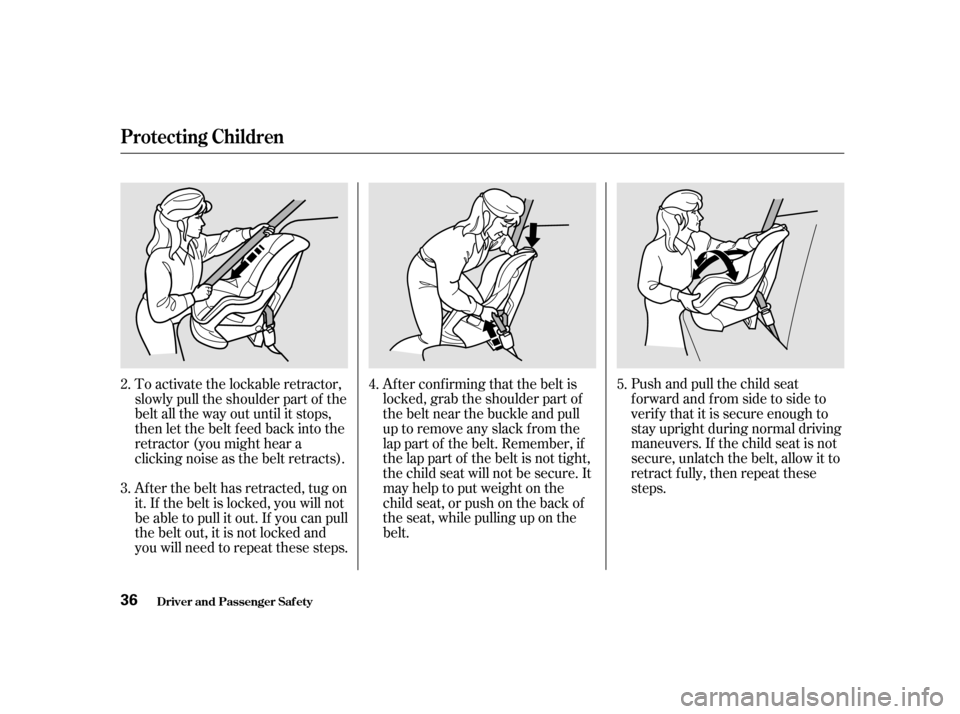
Pushandpullthechildseat
f orward and f rom side to side to
verif y that it is secure enough to
stay upright during normal driving
maneuvers. If the child seat is not
secure, unlatch the belt, allow it to
retract f ully, then repeat these
steps.
Af ter conf irming that the belt is
locked, grab the shoulder part of
the belt near the buckle and pull
up to remove any slack from the
lap part of the belt. Remember, if
the lap part of the belt is not tight,
the child seat will not be secure. It
mayhelptoputweightonthe
child seat, or push on the back of
the seat, while pulling up on the
belt.
To activate the lockable retractor,
slowly pull the shoulder part of the
belt all the way out until it stops,
then let the belt f eed back into the
retractor (you might hear a
clicking noise as the belt retracts).
Af ter the belt has retracted, tug on
it. If the belt is locked, you will not
be able to pull it out. If you can pull
the belt out, it is not locked and
you will need to repeat these steps. 4.
5.
2.
3.
Protecting Children
Driver and Passenger Saf ety36
Page 40 of 320

When a child reaches the
recommended weight or height limit
for a forward-facing child seat, the
child should sit in the back seat and
wear a lap/shoulder belt.
If a child is too short f or the shoulder
part of the belt to properly f it, we
recommend that the child use a
booster seat until the child is tall
enough to use the seat belt without a
booster.
The f ollowing pages give
instructions on how to check proper
seat belt f it, what kind of booster
seat to use if one is needed, and
important precautions f or a child
who must sit in the f ront seat.
To deactivate the locking
mechanism in order to remove a
child seat, unlatch the buckle,
unroute the seat belt, and let the belt
fully retract.
Protecting L arger Children
Protecting Children
Driver and Passenger Saf ety37
Allowing a larger child to sit
improperly in the front seat can
result in injury or death if the
passenger’s front airbag inflates.
If a larger child must sit in front,
make sure the child moves the
seat as far back as possible
and wears the seat belt properly.
Page 47 of 320
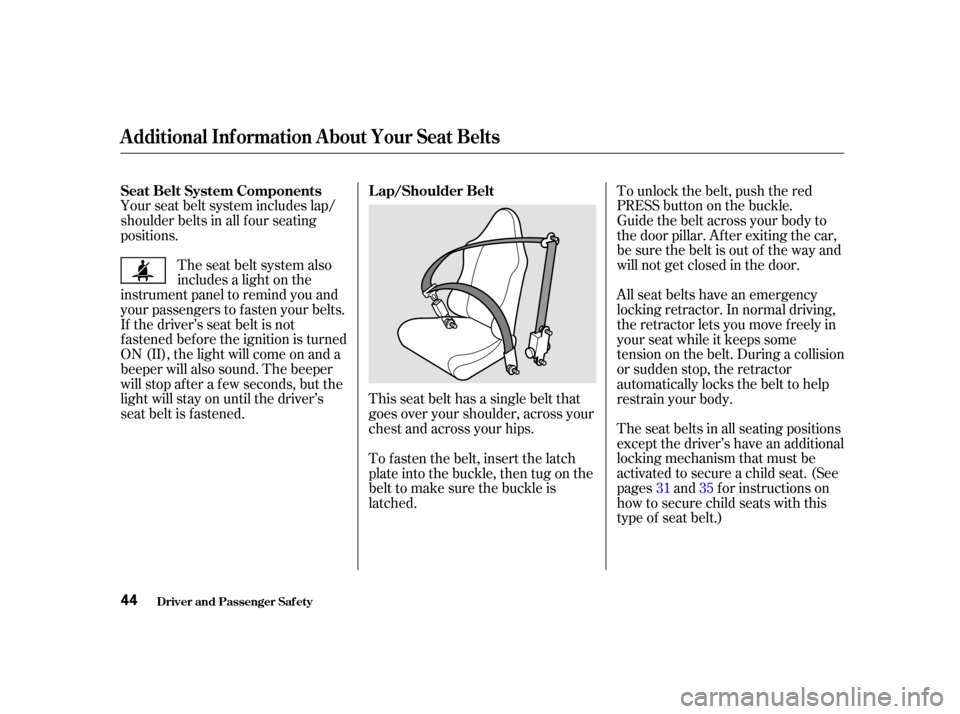
This seat belt has a single belt that
goes over your shoulder, across your
chest and across your hips.
The seat belt system also
includes a light on the
instrument panel to remind you and
your passengers to f asten your belts.
If the driver’s seat belt is not
fastened before the ignition is turned
ON (II), the light will come on and a
beeper will also sound. The beeper
will stop af ter a f ew seconds, but the
light will stay on until the driver’s
seat belt is f astened. The seat belts in all seating positions
except the driver’s have an additional
locking mechanism that must be
activated to secure a child seat. (See
pages and f or instructions on
how to secure child seats with this
type of seat belt.) All seat belts have an emergency
locking retractor. In normal driving,
the retractor lets you move f reely in
your seat while it keeps some
tension on the belt. During a collision
or sudden stop, the retractor
automatically locks the belt to help
restrain your body. Guide the belt across your body to
the door pillar. Af ter exiting the car,
be sure the belt is out of the way and
will not get closed in the door. To unlock the belt, push the red
PRESSbuttononthebuckle.
To fasten the belt, insert the latch
plate into the buckle, then tug on the
belt to make sure the buckle is
latched.
Your seat belt system includes lap/
shoulder belts in all f our seating
positions.
31 35
Seat Belt System Components L ap/Shoulder Belt
Additional Inf ormation About Your Seat Belts
Driver and Passenger Saf ety44
Page 48 of 320
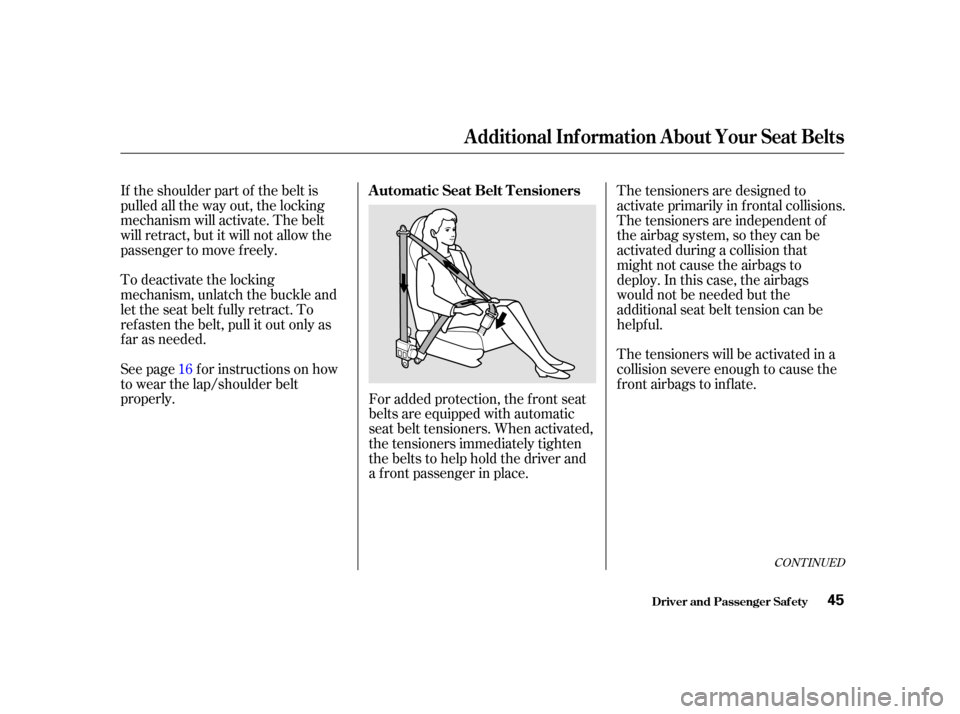
If the shoulder part of the belt is
pulled all the way out, the locking
mechanism will activate. The belt
will retract, but it will not allow the
passenger to move f reely.
To deactivate the locking
mechanism, unlatch the buckle and
let the seat belt f ully retract. To
ref asten the belt, pull it out only as
f ar as needed.
See page f or instructions on how
to wear the lap/shoulder belt
properly.The tensioners are designed to
activate primarily in f rontal collisions.
The tensioners are independent of
the airbag system, so they can be
activated during a collision that
might not cause the airbags to
deploy. In this case, the airbags
would not be needed but the
additional seat belt tension can be
helpf ul.
The tensioners will be activated in a
collision severe enough to cause the
f ront airbags to inf late.
For added protection, the f ront seat
belts are equipped with automatic
seat belt tensioners. When activated,
the tensioners immediately tighten
the belts to help hold the driver and
a f ront passenger in place.
16
CONT INUED
A utomatic Seat Belt T ensioners
Additional Inf ormation About Your Seat Belts
Driver and Passenger Saf ety45
Page 60 of 320
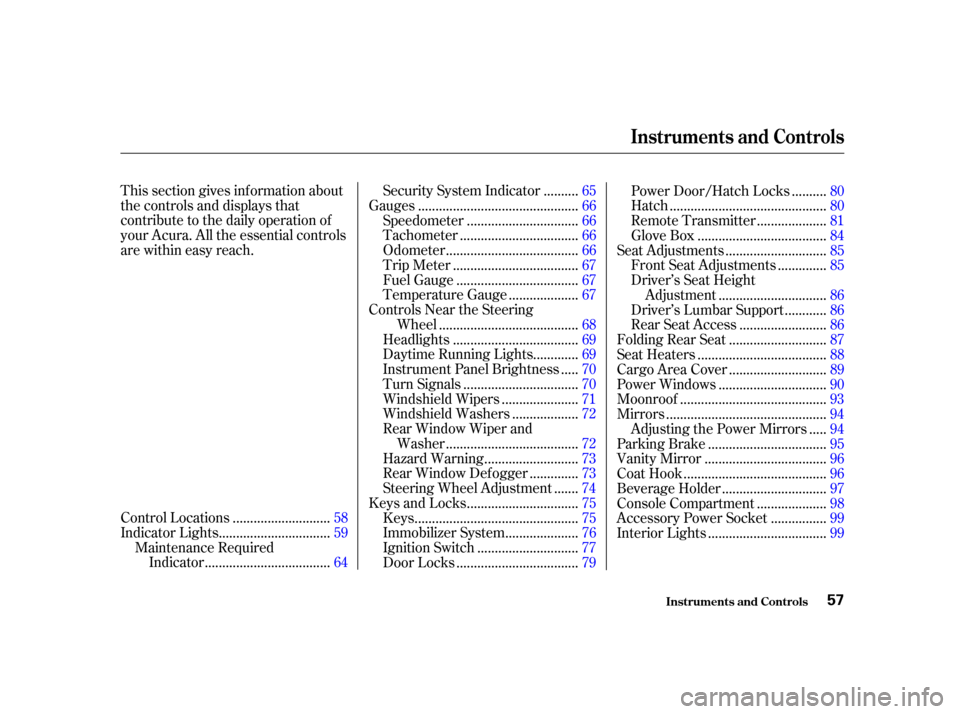
This section gives inf ormation about
the controls and displays that
contribute to the daily operation of
your Acura. All the essential controls
are within easy reach............................
Control Locations .58
...............................
Indicator Lights .59
Maintenance Required ...................................
Indicator .64 .........
Security System Indicator . 65
.............................................
Gauges .66
...............................
Speedometer .66
.................................
Tachometer .66
.....................................
Odometer .66
...................................
Trip Meter .67
..................................
Fuel Gauge .67
...................
Temperature Gauge . 67
Controls Near the Steering .......................................
Wheel .68
...................................
Headlights .69
............
Daytime Running Lights . 69
....
Instrument Panel Brightness . 70
................................
Turn Signals .70
.....................
Windshield Wipers .71
..................
Windshield Washers . 72
Rear Window Wiper and .....................................
Washer .72
..........................
Hazard Warning .73
.............
Rear Window Def ogger . 73
......
Steering Wheel Adjustment . 74
...............................
Keys and Locks .75
..............................................
Keys .75
....................
Immobilizer System . 76
............................
Ignition Switch .77
..................................
Door Locks .79 .........
Power Door/Hatch Locks . 80
............................................
Hatch .80
...................
Remote Transmitter . 81
....................................
Glove Box .84
............................
Seat Adjustments .85
.............
Front Seat Adjustments . 85
Driver’s Seat Height ..............................
Adjustment .86
...........
Driver’s Lumbar Support . 86
........................
Rear Seat Access .86
...........................
Folding Rear Seat .87
....................................
Seat Heaters .88
...........................
Cargo Area Cover .89
..............................
Power Windows .90
.........................................
Moonroof .93
.............................................
Mirrors .94
....
Adjusting the Power Mirrors . 94
.................................
Parking Brake .95
..................................
Vanity Mirror .96
........................................
Coat Hook .96
.............................
Beverage Holder .97
...................
Console Compartment . 98
...............
Accessory Power Socket . 99
.................................
Interior Lights .99
Instruments and Controls
Inst rument s and Cont rols57
Page 64 of 320
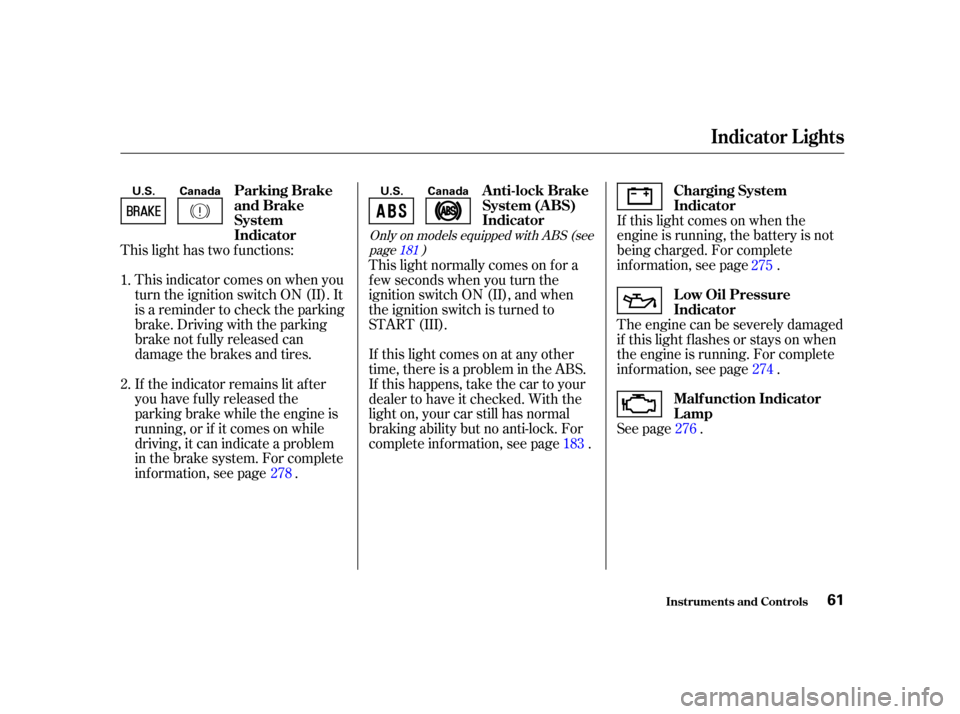
This light has two f unctions:This indicator comes on when you
turn the ignition switch ON (II). It
is a reminder to check the parking
brake. Driving with the parking
brake not f ully released can
damage the brakes and tires.
If the indicator remains lit after
you have f ully released the
parking brake while the engine is
running, or if it comes on while
driving, it can indicate a problem
in the brake system. For complete
inf ormation, see page . If this light comes on when the
engine is running, the battery is not
being charged. For complete
inf ormation, see page .
The engine can be severely damaged
if this light f lashes or stays on when
the engine is running. For complete
inf ormation, see page .
See page .
This light normally comes on f or a
f ew seconds when you turn the
ignition switch ON (II), and when
the ignition switch is turned to
START (III).
If this light comes on at any other
time, there is a problem in the ABS.
If this happens, take the car to your
dealer to have it checked. With the
light on, your car still has normal
braking ability but no anti-lock. For
complete inf ormation, see page .
1.
2.
278 183275
274
276
Only on models equipped with ABS (see page ) 181
Inst rument s and Cont rols
Indicator L ights
Parking Brake
and Brake
System
Indicator Anti-lock Brake
System (A BS)
Indicator
Charging System
Indicator
L ow Oil Pressure
Indicator
Malf unction Indicator
Lamp
61
U.S. Canada
U.S. Canada
Page 66 of 320
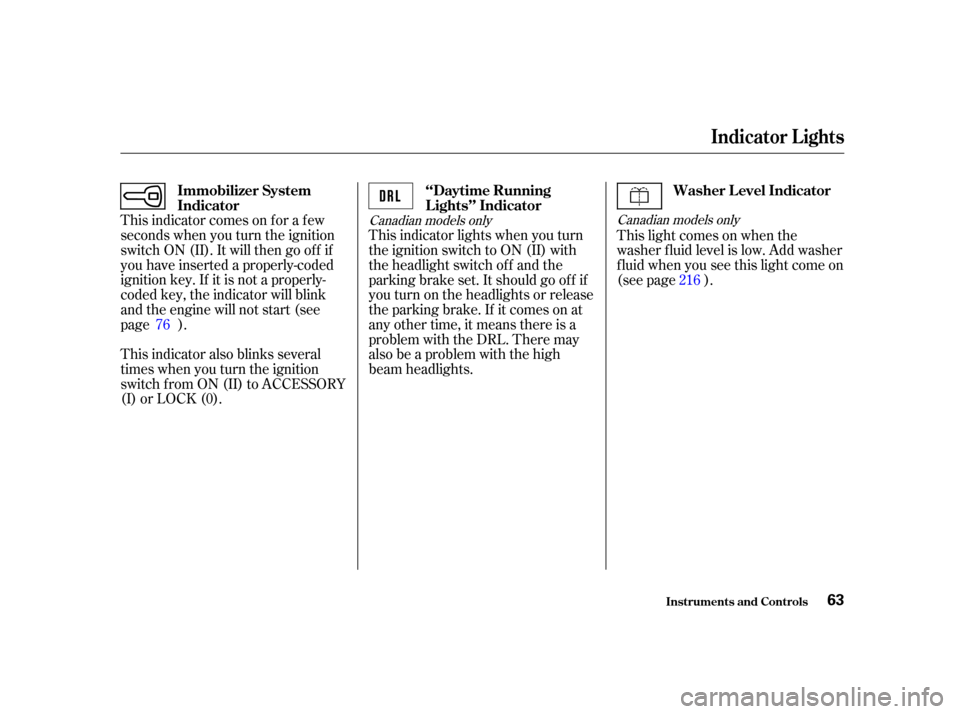
This indicator comes on f or a f ew
seconds when you turn the ignition
switch ON (II). It will then go of f if
you have inserted a properly-coded
ignition key. If it is not a properly-
coded key, the indicator will blink
and the engine will not start (see
page ).
This indicator also blinks several
times when you turn the ignition
switch f rom ON (II) to ACCESSORY
(I) or LOCK (0).This indicator lights when you turn
the ignition switch to ON (II) with
the headlight switch of f and the
parking brake set. It should go of f if
youturnontheheadlightsorrelease
the parking brake. If it comes on at
any other time, it means there is a
problem with the DRL. There may
also be a problem with the high
beam headlights.
This light comes on when the
washer f luid level is low. Add washer
f luid when you see this light come on
(see page ).
76 216Canadian models only
Canadian models only
Indicator L ights
Inst rument s and Cont rols
Immobilizer System
Indicator Washer Level Indicator
‘‘Daytime Running
Lights’’ Indicator
63
Page 72 of 320
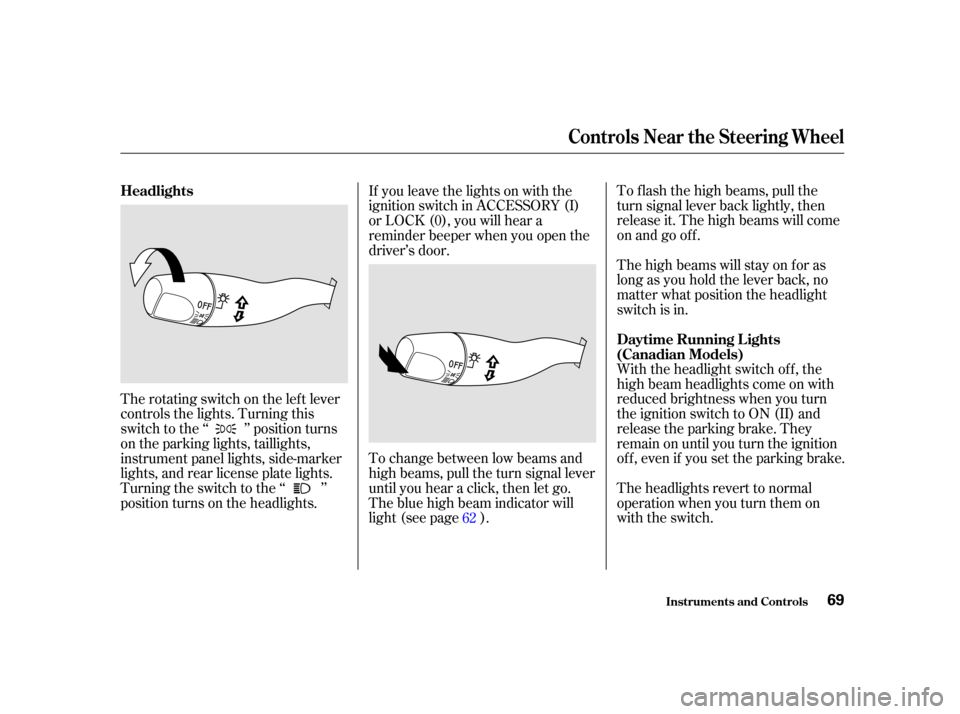
To f lash the high beams, pull the
turn signal lever back lightly, then
release it. The high beams will come
on and go off.
The high beams will stay on f or as
long as you hold the lever back, no
matter what position the headlight
switch is in.
With the headlight switch off, the
high beam headlights come on with
reduced brightness when you turn
the ignition switch to ON (II) and
release the parking brake. They
remain on until you turn the ignition
of f , even if you set the parking brake.
To change between low beams and
high beams, pull the turn signal lever
until you hear a click, then let go.
The blue high beam indicator will
light (see page ). The headlights revert to normal
operation when you turn them on
with the switch.
The rotating switch on the lef t lever
controls the lights. Turning this
switch to the ‘‘ ’’ position turns
on the parking lights, taillights,
instrument panel lights, side-marker
lights, and rear license plate lights.
Turning the switch to the ‘‘ ’’
position turns on the headlights. If you leave the lights on with the
ignition switch in ACCESSORY (I)
or LOCK (0), you will hear a
reminder beeper when you open the
driver’s door.
62
Headlights
Daytime Running L ights
(Canadian Models)
Controls Near the Steering Wheel
Inst rument s and Cont rols69
Page 75 of 320

To operate the wipers in mist mode,
push the control lever up f rom the
OFF position. The wipers run at high
speed until you release the lever.
This gives you a quick way to clear
the windshield.To clean the windshield, pull back on
the wiper control lever. The washers
spray until you release the lever.
To turn on the rear window wiper,
turn the rotary switch clockwise to
ON. To also use the rear window
washer, turn the rotary switch
clockwise past ON. The washer will
spray as long as you hold the rotary
switch in this position. If you turn the
rotary switch counterclockwise f rom
the OFF position, the washer will
spray without activating the rear
window wiper.
Controls Near the Steering Wheel
Inst rument s and Cont rols
Windshield Washers
Rear Window Wiper and Washer
72
Page 77 of 320
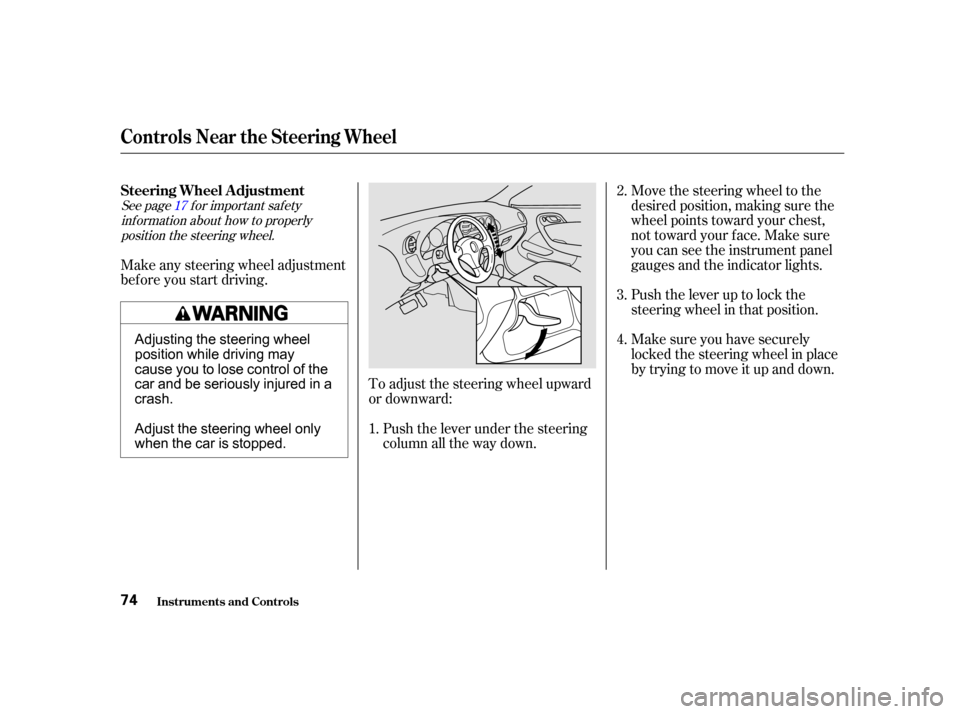
See page f or important saf etyinf ormation about how to properlyposition the steering wheel. 17
Make any steering wheel adjustment
bef ore you start driving.
To adjust the steering wheel upward
or downward:Push the lever under the steering
column all the way down. Move the steering wheel to the
desired position, making sure the
wheel points toward your chest,
not toward your f ace. Make sure
you can see the instrument panel
gauges and the indicator lights.
Push the lever up to lock the
steering wheel in that position.
Make sure you have securely
locked the steering wheel in place
by trying to move it up and down.
1. 3.
4. 2.
Controls Near the Steering Wheel
Inst rument s and Cont rols
Steering Wheel A djustment
74
Adjusting the steering wheel
position while driving may
cause you to lose control of the
car and be seriously injured in a
crash.
Adjust the steering wheel only
when the car is stopped.